Welcome to the world of polyculture, an approach to gardening that embraces diversity and mimics natural ecosystems.
The Comprehensive Guide to Maintaining Dianella
For those who appreciate a lush, vibrant garden that’s easy to maintain, the Australian flax, or dianella, is a perfect choice to add to your plant palette. This comprehensive guide will equip you with all the knowledge you need to keep your dianella thriving.
Understanding Dianellas
Dianellas boast beautiful, blue or purple flowers that mature into ornamental berries, lush foliage and a robust system of rhizomes and roots that contribute to their resilience and longevity.
While they share a common name with the New Zealand flax, these two plants are quite different. The Australian flax belongs to the Dianella genus, while NZ flax belongs to the Phormium genus. They can be distinguished by their flowers, fruits and most noticeably, their size. NZ flax are often much larger than our native Aussie flax plants, although there’s some overlap between the largest Australian flax and the smallest NZ flax.
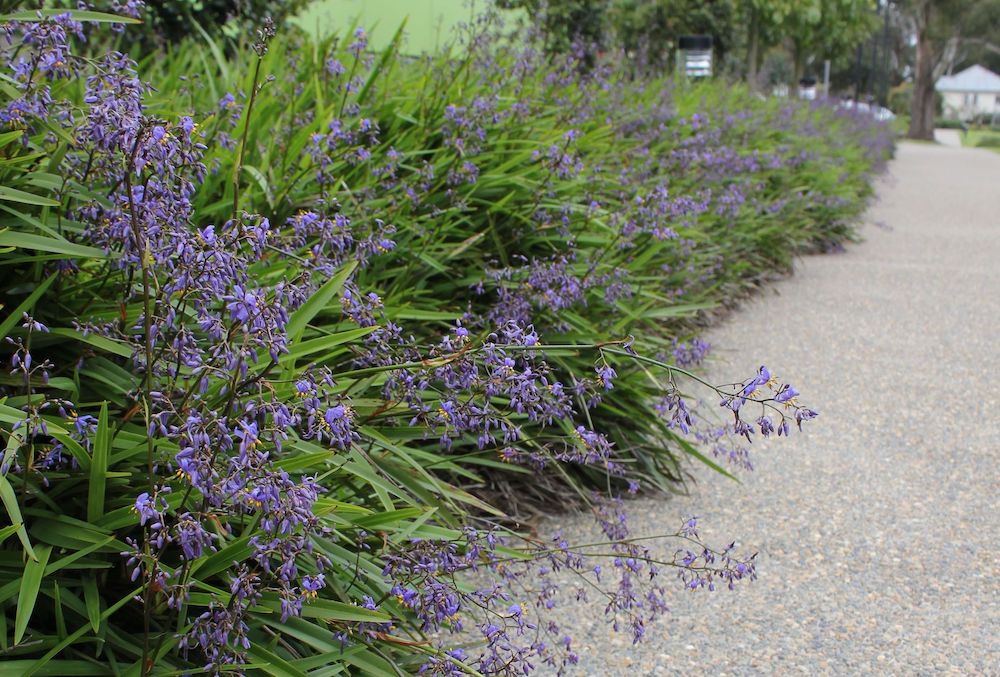
Dianella Maintenance: Step by Step
While there are a variety of Dianella species and cultivated varieties, which we’ll speak about later in this article, they all share similar needs with some subtle differences.
Growing Dianellas in an Appropriate Location
Different natural Dianella species have varying preferences when it comes to growing conditions. For instance, Dianella tasmanica prefers well-drained soils and partial shade, while Dianella caerulea can tolerate a wider range of conditions, from full sun to dappled shade. Understanding these nuances will help you choose the right Australian flax plant for your garden’s conditions.
Plant breeders have cultivated a range of cultivars that have enhanced certain dianella characteristics to become more suited to growing in the landscape. This includes enhanced beauty, more vigorous growth, and resistance to pests and diseases.
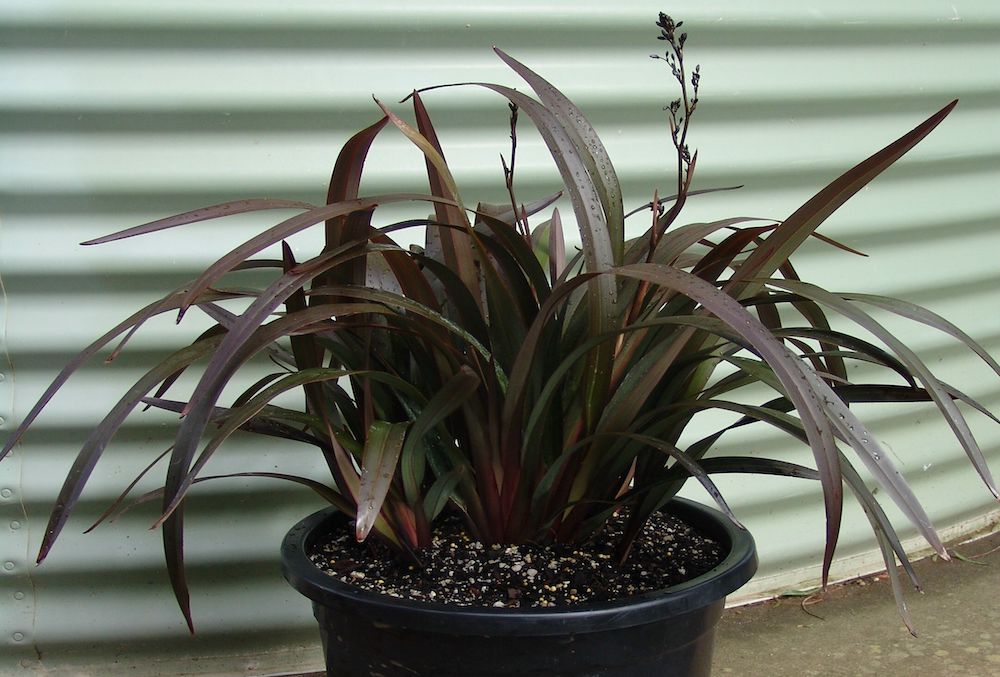
Watering Your Dianella: Striking the Right Balance
Overwatering and underwatering can both lead to problems for your dianella. Signs of overwatering include yellowing leaves and a wilting appearance, even when the soil is wet. On the other hand, underwatered Dianellas may have dry, brown leaf tips and a generally lacklustre appearance.
When watering your dianella, aim to water deeply but infrequently. This method encourages the roots to grow downward in search of moisture, resulting in a stronger, healthier plant. Use a slow-release watering method, such as a soaker hose or drip irrigation system, rather than a jet of water for a short period of time.
Water your dianella in the morning. This allows the water to soak into the soil before the heat of the day causes it to evaporate. It also gives the foliage a chance to dry out, reducing the risk of fungal diseases.
Remember, your dianella’s watering needs will change with the seasons. In hot, dry summer months, you’ll need to water more frequently than in the cooler, wetter winter months. Always adjust your watering schedule based on current weather conditions and the specific needs of your dianella species.
Watering your Dianella properly will not only keep it looking its best, but will also enhance its overall health, making it more resistant to pests and diseases. While it’s true that Australian flax plants can survive with minimal watering, they’ll look their best with adequate water.
Fertilising Dianella
Dianella plants thrive when provided with a balanced fertiliser during their growing season. This ensures they receive all the necessary nutrients for robust growth and vibrant blooms.
Chemical fertilisers will deliver the essential nutrients your plants need, but an organic fertiliser will often provide a broader spectrum of micronutrients and will also feed the soil microbes that are allies in your plant’s health.
Composted plant material and manure, blood and bone, and other organic matter are all great options that will help keep your plant looking its best.
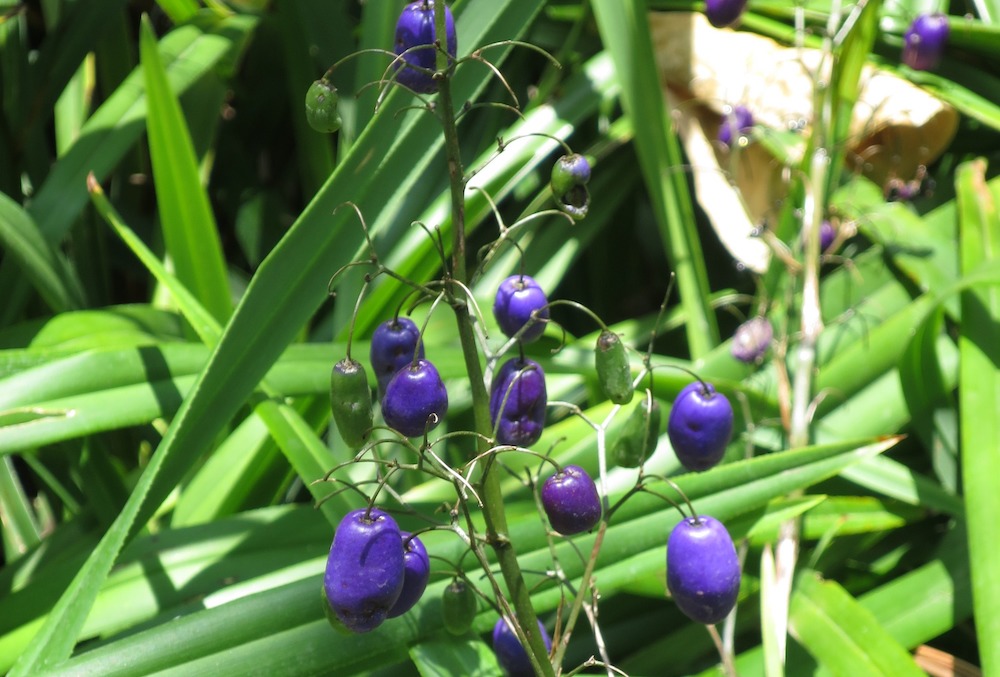
Mulching Around Dianella
Organic mulch made from plant material protects the upper soil layer from the harsh sun, helping it to retain moisture and keep the existing soil microbes alive. It also breaks down over time, adding carbon to the soil which improves structure and feeds those very microbes.
Around 5-10 cm is ideal. Just make sure you aren’t covering the leaves with the mulch; we want leaves in the air, and roots submerged in the soil.
Top up the mulch every few years and avoid composting on top of it. I know it’s a bit more work, but scrape the mulch back and put your compost on top of the soil, before spreading the mulch back over the compost. This can help to “fluff up” the mulch, making it appear more fresh.
Choose a mulch made from larger bark chunks rather than finer particles, which will help water filtrate through to the root zone, rather than rolling off the top and into the gutter.
Pruning Dianella
Pruning your Dianella is optional. While some gardeners prefer to prune their plants into a neat dome shape, this requires regular maintenance.
Leaving Dianella in its natural shape can be just as attractive, if not more attractive, and is less labour-intensive. Whether or not you choose to prune the foliage, remember to remove dead leaves by hand and prune deadheads (spent flower stalks after the berries fall off) at the base to keep your plant looking its best.
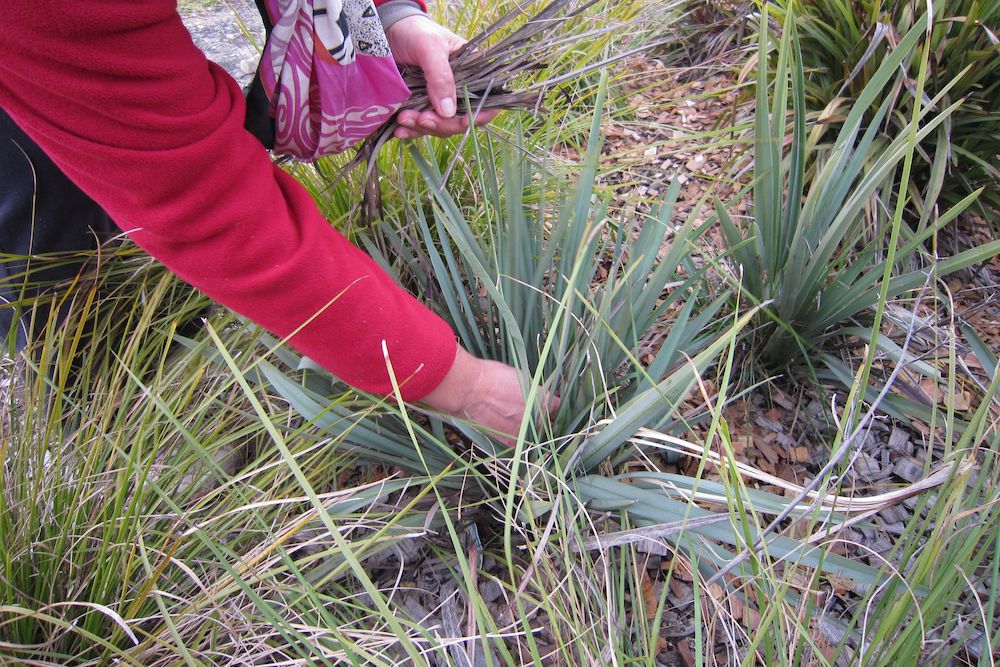
Dividing Dianella
Dividing Dianella is a straightforward process that can help rejuvenate older plants and propagate new ones. Once plants mature and become a tangled mess, you might want to thin a few of the plants out so that there’s more space available in your garden.
We’ll walk you through this process step by step.
- Choose the Right Time: The best time to divide Dianella is during the cooler months of the year, ideally late winter to early spring, when the plant isn’t actively growing. This reduces stress on the plant and gives it plenty of time to establish roots before the hot, dry summer months. Your plants should be healthy before you divide – if they’re thirsty, give them a drink.
- Prepare Your Tools: You’ll need a sharp, clean spade, trowel or garden knife.
- Dig Up the Plant: Carefully dig around the base of your dianella, taking care not to damage the roots too much. Lift the plant out of the ground carefully, taking care to damage the roots as little as possible.
- Replant Immediately: Plant your new dianella divisions as soon as possible. If planting back into the ground, prepare the soil by adding some compost or organic matter. Place the division in the hole, ensuring it’s at the same depth as it was previously. Firmly pack the soil around the roots.
- Water Well: Give your newly planted Dianellas a good drink of water. Keep the soil moist but not waterlogged for the first few weeks while the plant establishes.
When plants are protected by plant breeder’s rights (PBR), they mustn’t be propagated for sale. You’re only allowed to propagate them for your own use. Nurseries employ special methods, often involving tissue culture, to cultivate them.
Depending on your schedule, it could be easier and more cost-effective to buy new plants. Nevertheless, if you have the time and aren’t planning to sell them, it might be worth doing it on your own.
Dianella Weeds
While natural Dianella species can have viable seeds that tend to pop up new plants where they aren’t wanted, some cultivars have been bred to become less vigorous in their weed potentiality.
Choosing tissue culture plants, such as those from the Ozbreed catalogue, reduces the risk of your garden becoming overgrown with unwanted dianellas.
If you really do want to propagate new plants, you can simply divide your existing clump and transplant the pups into the desired space. Your “new” plants will look and behave exactly the same as the mother plant you’ve divided from.
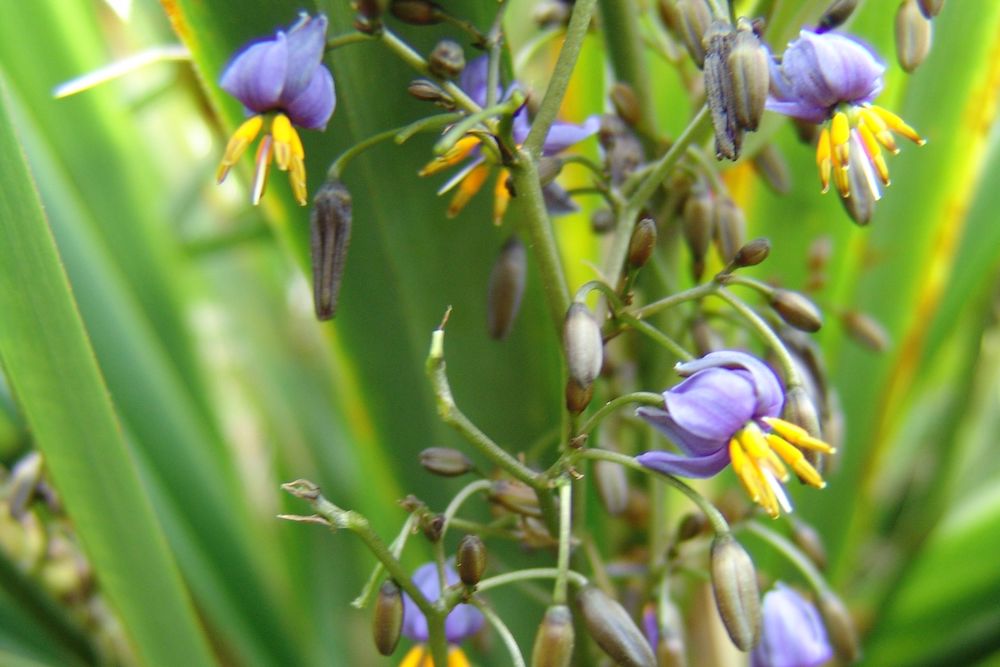
Troubleshooting Common Dianella Issues: Keeping Your Plants Healthy and Vibrant
Despite your best efforts, dianella plants can sometimes experience problems. Let’s delve into some of the common issues and learn how to tackle them effectively.
Yellowing Leaves
If you notice the leaves of your Dianella turning yellow, it could be a sign of overwatering or poor drainage. Ensure your plant isn’t sitting in waterlogged soil and reduce your watering schedule. In some cases, yellow leaves can also indicate a nutrient deficiency, particularly nitrogen. Applying a balanced fertiliser can help rectify this issue.
Burnt Leaves
If your leaves have scorch marks on them, they could be receiving too much sunlight. Either you’ve planted them in the wrong place, or a previous source of shade has been removed before they had a chance to adapt to the new sunlight conditions. Sometimes, burnt leaves can indicate a deeper issue like a fungal disease.
Root Rot
Root rot is typically caused by overwatering or poor drainage. If your Dianella has soggy, decaying roots or stunted growth, root rot might be the culprit. To treat root rot, you may need to remove the affected plant and improve the soil drainage before replanting. Or, you can replace your plant with something more suited to a wet space.
Fungal Symptoms
Fungal diseases, such as leaf spot or rust, can affect dianellas. These are usually identified by discoloured spots or patches on the leaves. To manage fungal issues, remove affected foliage, and avoid overhead watering which keeps leaves wet. Consider consulting with a qualified horticulturist before using a fungicide, which can have negative long-term effects on the soil microbiome, and consequently, your dianellas.
Lacklustre Growth
If your dianella isn’t growing as robustly as it should, it might not be getting enough light, water, or nutrients. Ensure your plant is in a suitable spot with enough sunlight and adjust your watering or feeding routine as needed.
Insect Pests
Pests, such as aphids or scale, can occasionally trouble dianella plants. Keep an eye out for any unusual spots, bumps, white “cotton wool,” or creepy crawlies on your plants.
Most insect pests can be managed by keeping your dianellas happy and providing them with a healthy ecosystem that’s home to plenty of predatory insects. To achieve this, you can ensure that there’s a constant source of nectar to feed the adult life-cycle of insects such as hoverflies and micro wasps, which will lay their eggs inside of many types of insect pests.
Remember that not all critters are pests; many such as lacewings, ladybirds and spiders are there to eat the pests that often plague our plants, and using broad-spectrum chemical pesticides will hurt them just as much as the “baddies.”
Healthy Dianella plants are more resistant to pests and diseases, so by ensuring your plants have the right growing conditions and proper care, you can prevent many common issues. However, if problems persist, don’t hesitate to seek advice from a local horticulture expert or your nearest nursery or garden centre.
Different Dianella Species
Now that we’ve been over some of the general care tips for Australian flax, let’s explore four of the most common species that you’re likely to encounter, as well as a cultivated variety of each species that’s been bred for superior performance and beauty for your garden.
Dianella caerulea
The Dianella Caerulea, also known as the blue flax lily, is a robust and versatile species. Its growth habit is typically clumping, with slender, strap-like leaves that can reach up to 1 metre in height. This plant is adaptable to a variety of conditions, from full sun to part shade, and it can withstand both drought and frost. It’s a low maintenance species, requiring only occasional watering once established.
Dianella tasmanica
The Dianella tasmanica, or Tasman flax lily, stands out with its stunning deep purple berries. Like D. caerulea, it has a clumping growth habit, but tends to grow slightly taller, up to 1.5 metres. It prefers moist, well-drained soil and partial shade. Regular watering and feeding with a slow-release fertiliser will ensure healthy growth. While it is not as drought-tolerant as D. caerulea, D. tasmanica is a hardy plant that thrives in cool climates.
Dianella revoluta
Dianella Revoluta, known as the black-anther flax lily, is a coastal dweller. It has a more spreading growth habit, reaching 0.5 to 1 metre in height. It’s highly tolerant of salty winds and sandy soils, making it an excellent choice for seaside gardens. D. revoluta requires well-drained soil and full sun to part shade. It’s a tough species that can withstand dry conditions and requires minimal care once established.
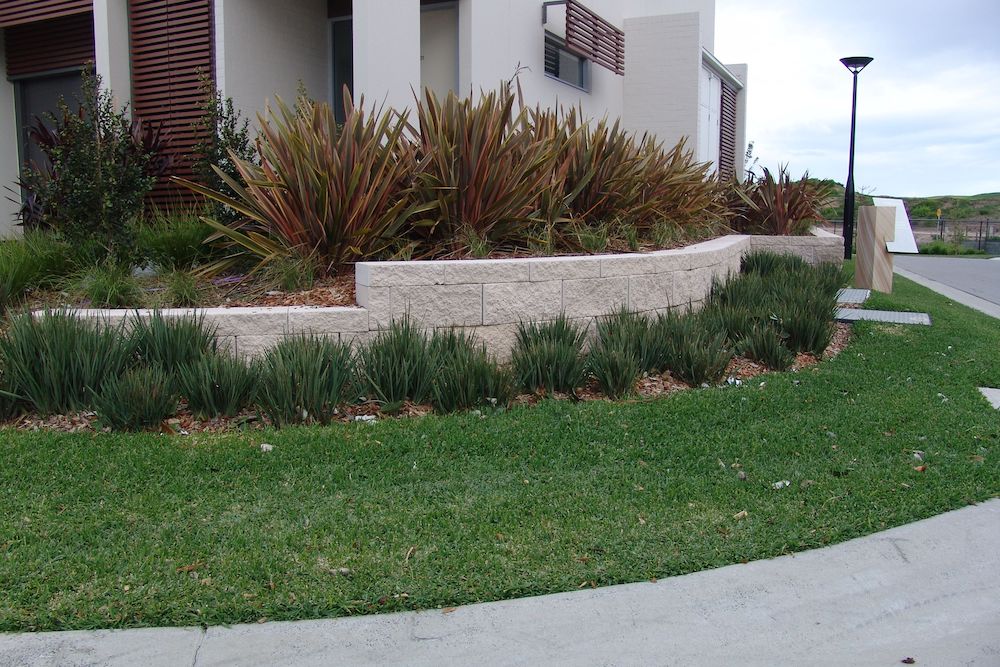
Dianella prunina
Lastly, Dianella prunina, or purple flax lily, is a compact plant with a clumping growth habit, reaching heights of 0.6 to 1 metre. It boasts deep purple foliage and bright blue flowers, offering a striking contrast. D. prunina prefers well-drained soil and full sun to part shade. While it requires regular watering in the initial stages, it becomes highly drought-tolerant once established.
While it’s good to know the basic preferences of these native species, it’s important to remember that once they’ve been selectively bred to become a new cultivated variety, they’ll likely take on new characteristics. This often makes cultivated varieties superior performers in the urban landscape.
Daniel’s Wrap
Maintaining a Dianella plant is a rewarding experience, particularly when you’re equipped with the right knowledge. From understanding the unique characteristics of Dianella to mastering its care needs, this guide has covered all the bases.
Now, it’s time to put these insights into practice and watch your Dianella plants flourish!

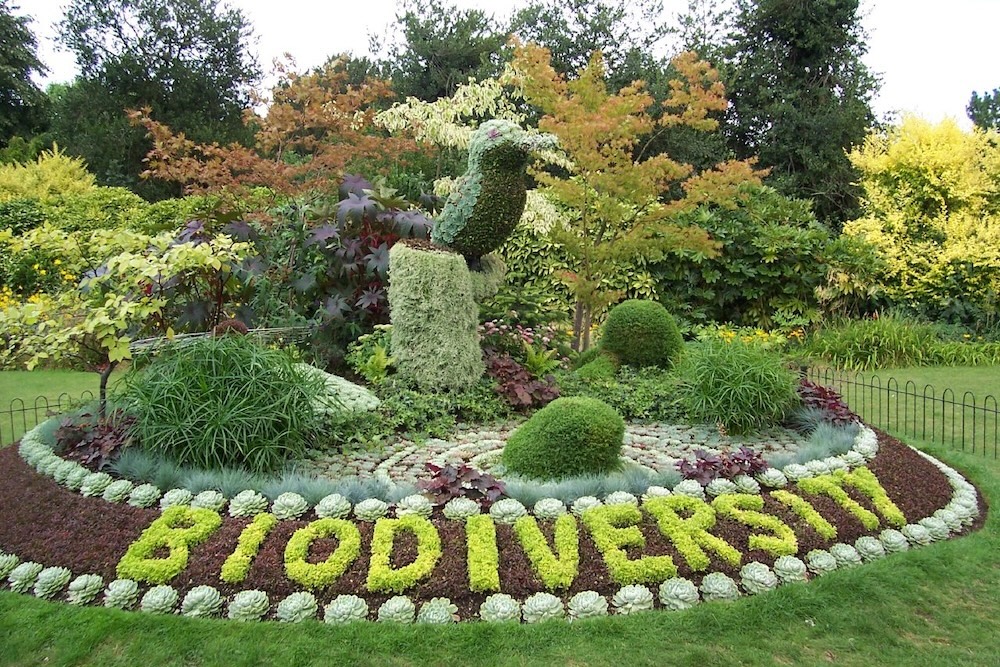
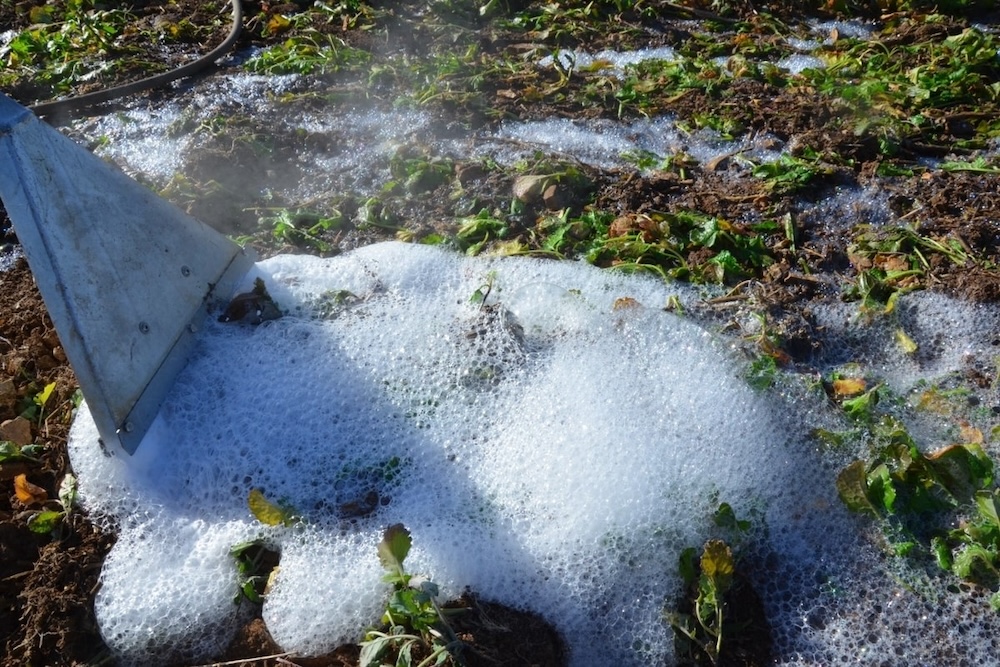
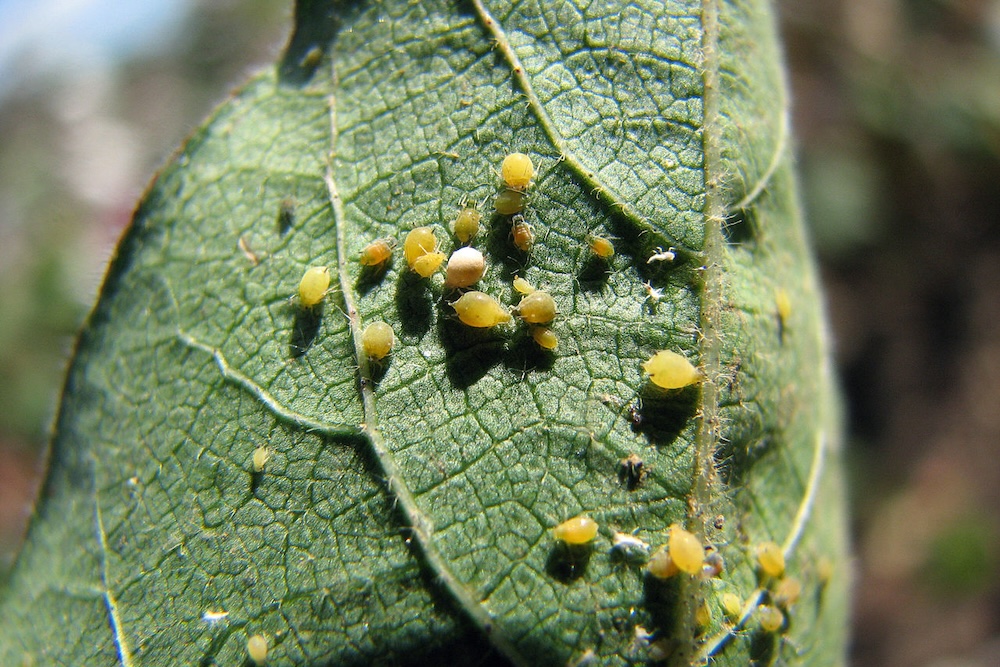
This Post Has 0 Comments